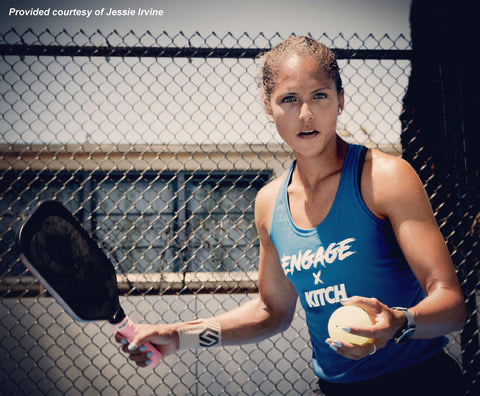After a couple of years, the National Bank Open - formally Rogers Cup - was back at it last month. I’m glad that in the past I’ve seen Serena Williams compete, because this year I sadly missed watching her play.
Since her announcement on retirement, there has been speculation on whether the tennis legend is going to jump into the world of pickleball (but, word on the street is that she already has made some business moves in the pickleball industry).
During the tournament, I observed the players with a close eye, looking at the cross-overs and comparisons between tennis and pickleball.
Maybe I’m stating the obvious (for some of you) but as much as we feel pickleball and tennis have one huge thing in common: the game is all about repetition...
Preparation Repetition
The way in which high level players set up to perform their serve is completely unique, however, each player will have a consistent way of approaching their serve.
This allows the player time to get focused on the rally, push the previous points behind them and oftentimes to even out their breathing as well.
Remember, in competition a player has 10 seconds to make their serve after the score has been called. Rushing into the serve is less effective than taking that time to set up and prepare yourself for the rally.
Pro player, Jesse Irvine consistently prepares for her serve by bouncing the ball on the ground with her paddle about 4-5 times before taking hold of the ball in her left hand for the serve.

Photo credit: Jesse Ivine & The Pickler
For anyone who’s played other sports, this preparation very much occurs across the board. With my newer students, I make this comparison a lot: imagine an NBA player getting ready to shoot at the free throw line.
No matter how often they shoot from the line during a game, their set up is always the same. Even in high school, that’s the way I was taught to approach every single free throw.
With tennis, each player has a “routine” before they begin their serve. I can vividly picture Canadian player Dennis Shapovalov bouncing the ball between his legs as he prepares.
Shot Repetition
People are often surprised with how good of a workout pickleball actually is. The game looks simple to play and it’s pretty easy to pick up on how to play.
However, the way pickleball is played at an entry level versus competitive level is vastly different. One main difference that is easy to point out is the level of consistency.
Advanced players have developed ball control which is extremely important while rallying at the non-volley line. By having control of the ball, a player can keep the ball low to the net as it passes over to the other side and they can also control the height that the ball bounces.
An advanced player can hit multiple low offensive shots over and over again - sometimes 20+ shots in a row before another shot is used or an error is forced. Keeping the amount of unforced errors lower than your opponent is often the difference between winning and losing.
This ultimate ball control is driven from the legs up, so what's actually required with repetitive shots at the non-volley line is the ability to do multiple squats and lateral lunging. Learning to embrace the dinking game is a solid long term pickleball outlook.
Although undetected speed-ups and fast, aggressive play is the more popular way to play these days, getting your body comfortable with performing multiple dinks is just smart strategy.
On the flip side, there are serial lobbers out there. They can be hard to identify but once they commit their first lob it’s usually a sign that there’s more to come. If you don’t chase down a lob, but watch it and hope that it lands outside of the court, chances are more lobs are going to come your way.
Repetitive Practicing
Above anything, I recommend practicing pickleball and not just playing pickleball. If certain shots or repetitive rallies have you feeling a little bit checked out then challenge yourself to practice these types of shots and rallies.
If it’s a lack of confidence or familiarity, practice will allow you to develop the weaker areas. If it’s pure boredom, then heck, you might just remain bored with certain aspects of the game.
But for example, if you're bored of dinking (and you’re really good at it) why not practice turning dinking into an offensive situation or practice defending an opponent who’s good at turning dinking into an offensive situation?
And for those of you who dislike serial lobbers, I definitely recommend incorporating lob-work into your practices.
-Sep-23-2022-03-42-52-72-PM.png?upscale=true&width=1024&upscale=true&name=unnamed%20(1)-Sep-23-2022-03-42-52-72-PM.png)
Photo credit: Pickleball University
Mental Repetition
I believe a part of why people can’t get used to repetitive dinks is because their minds can’t stay in the rally. While it can be seen as a boring way to play pickleball, having that mindset is sort of detrimental right?
Because the reality is that there are teams that are better than yours and on any given day, anyone can win in pickleball.
Well, that better team just might be a better dinker and can lay down some serious resets, so what are you going to do if a team takes away your ability to attack the ball and forces you into the dinking game? If you can’t keep up, well, it might just be game over.
It’s time for all of us to accept the repetition within pickleball. It’s kind of why this game is great, at least, in my opinion.
That’s not to say I don’t get frustrated by it sometimes, but ultimately, I feel that pickleball is about who can stay in the rally longer than the other, mentally and physically; and it’s a test of ones stamina and strength.
This article was taken from our 'Control the Kitchen' Newsletter, if you're interested in receiving more content like this, please feel free to sign up using the subscribe section located at the bottom left of this page (or underneath the article if you're on mobile), thanks!
